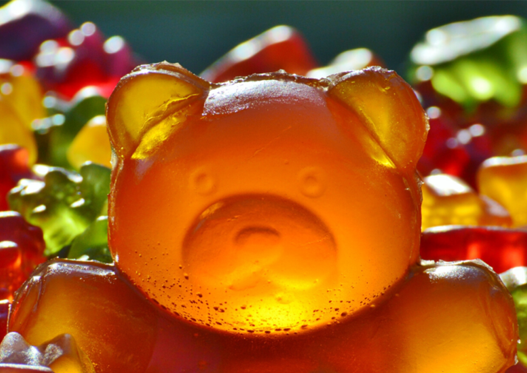What does that even mean? A food that is not a food?? Food is food right? It’s the stuff they sell at the grocery store. The stuff we put into our mouths. The stuff our mothers made for us growing up. Isn’t that what food is?
Let’s find out.
There are things that us modern day humans eat that are not foods. We think they’re foods. We are taught they are foods growing up. They are in the FOOD pyramid. We may even think they taste good* (we’ll explore that asterisk later).
In our modern-day society, we automatically assume an item with these qualities constitutes a food:
- Sold as food in a grocery store
- Part of the food pyramid
- Our mothers fed it to us growing up
Is that a fair assessment? Can we assume that if an item we eat has the above characteristics, it is actually a food? If something contains all three of the above characteristics, is it actually food?
Let’s explore the actual definition of food. This is from the Oxford dictionary:
Food: ‘Any nutritious substance that people or animals eat or drink or that plants absorb in order to maintain life and growth.’
-Oxford dictionary
This is not a “holistic health” or natural medicine doctor’s definition of food. This is the definition of food in the Oxford dictionary. That’s THE dictionary.
There are two key points I want to focus on in the definition of food.
- The word “nutritious”
- The phrase “maintain life and growth”
Both of these points are highlighted in green to reiterate how important they are to the definition of food. According to the dictionary, food has to be nutritious and it must maintain life and growth. If food doesn’t do those two things, it is not a food according to the actual definition. Right?
A characteristic of all foods on earth is that they are grown. Whether foods are grown in the sea (salmon, crab, seaweed) or grown on land (lettuce, carrots, turkeys) food is something that grows. It doesn’t just magically show up one day, appearing out of nowhere. Herbivores eat plants that are grown. Carnivores eat food that is also grown from birth.
Another characteristic of foods is that we can eat them in their natural state. Meaning true foods don’t have to undergo any “processes” in order to become edible.
How about we add “Food is something that is grown” to the definition. We can also add “Food can be eaten in its natural state” But let’s get back to the ‘nutritious’ part of the Oxford definition of food.
What is the definition of nutritious?
Nutritious: Nourishing, efficient as food.’
-Oxford Dictionary
So let’s recap. A ‘food’ is a nutritious substance that maintains life and growth. And ‘nutritious’ means nourishing and efficient as food.
What is the opposite of nutritious? Non-nutritious. I’m going to apply Carl Jung’s ‘Principle of Opposites’ here and create my own definition of non-nutritious.
Non-nutritious: ‘Non-nourishing, inefficient as food’
-Dr. Jeni
My definition of non-nutritious is the exact opposite of the actual definition of nutritious.
Non: ‘A prefix meaning “not,” freely used as an English formative, usually with a simple negative force as implying mere negation or absence of something.’
What does all this mean? Very (very) simply, it means that something that isn’t nutritious and doesn’t maintain life and growth is not a food.
There are many obvious things that are not foods. Steel, wood, plastic, paper, cardboard – these are clearly not foods. A diet of these items are not nutritious and would not maintain life and growth. At least not human life.
The point I am getting at through all of these definitions is this: there are things we eat in our diet that are non-nutritious and ineffective for life and growth.
What are they? What are the “foods” that are not foods which we eat? Below is a comprehensive list.
- Dairy
- Gluten and most grains
- Sugar
- Artificial ingredients (dyes, preservatives, flavorings, binders and fillers)
Dairy.
This is a big one. Dairy is the mammary gland secretions of other mammals, predominantly bovine, sheep and goats. We are the only species on earth that drinks the mammary gland secretions meant for other creatures. Think about that.
I grew up in the “Got Milk” era of Michael Jordan and other celebrities posing with milk mustaches. I had a huge poster of the tennis player Serena Williams hanging in my room with the milkstache. I hated the taste of milk but I drank it to grow strong bones. Because of the calcium.
And dairy does contain calcium. It also causes an acidic reaction in our bodies. It sends our systems into shock and creates an immune response. To buffer the acidity, our bones eject calcium into the bloodstream. That’s right. We lose calcium drinking milk. In fact, the countries with the highest milk and dairy consumption in the world have the highest incidence of osteoporosis and bone fracture. In the world.
Dairy is actually a perfect food. It is 100% perfect. Perfect to turn a 65 pound calf into a 2000 pound adult cow. Complete with the hormones and antibodies meant to quickly turn that baby into a huge animal within a year. Humans are not meant to drink from the udders of cows or sheep or goats.
Dairy consumption in children leads to early breast development in girls, early onset of menses, and even breast development in boys.
Dairy includes things like milk, butter, cheese, ice cream, heavy cream, sour cream, yogurt – anything that contains milk or the derivatives of milk.
There have been studies showing dairy consumption has a direct correlation to breast, ovarian, uterine, prostate, and testicular cancers. Is a food that contributes to cancer and leeches calcium from bones a food?
Remember the definition of food we looked at before? Dairy robs our bodies of nutrition (calcium) and can cause certain cancers. Not nutritious. Not maintaining life and growth. When I think of cancer, I certainly don’t think “life”.
Gluten and most grains.
Gluten is a mixture of two proteins found in the wheat family. The wheat family is a large group of grains including wheat, oats, spelt, barley, rye, triticale, farro, einkorn, khorasan, and other grains.
Gluten punches tiny holes in the small intestine. Have you heard of “leaky gut”? The medical term is intestinal permeability and it’s what happens when we consume gluten and grains in general. Leaky gut is what occurs.when pathogenic bacteria, parasites, toxins and undigested food particles (yum) literally leak through the lining of the small intestine into the bloodstream. And gluten is a huge contributor to that. Even if you’re not “allergic”. Even if you don’t have celiac disease.
Gluten and wheat cause autoimmune diseases, thyroid disorders, intestinal cancers, lymphomas, eczema, allergies, asthma, and a long list of health issues that people ultimately don’t want and pay thousands, if not hundreds of thousands, of dollars to reverse.
Grains also contain anti-nutrients like phytic acid which prevent nutrients like minerals from being absorbed into our systems. If you’re eating a salad full of veggies and that salad has croutons in it you are not getting all the nutrients of the veggies. The phytic acid blocks the absorption and metabolization of what our bodies need. That leaves us with the option of eating more calories worth of food to make up for the nutrition lost. That leaves us over-fed and under-nourished.
Do you crave wheat? Do you ever wake up and say, “Man, I could really go for some raw grains of wheat”? Does your stomach growl when you drive by a wheat field? Do you think about getting out of your car and running through the amber waves of grain and eating mouthfuls directly from the plant?
If you’ve ever been apple picking with your family, you know what happens? You guys start eating apples. You don’t have to season them or alter them in any way, you can pick them right off the tree. Apples are delicious.
I have grown gardens and have planted many fruits and vegetables. Carrots, lettuce, radishes, herbs, strawberries, watermelons, onions, peppers, tomatoes, cucumbers, zucchini – I have eaten every one of these vegetables directly from the ground. Or tree. Or bush. Have you ever popped a ripe cherry tomato in your mouth? It’s delicious. Have you ever pulled a carrot you’ve grown out of the ground and crunched on that? Also delicious.
Now. Have you ever gone into a wheatfield and eaten raw wheat from the plant? Anyone? Of course not. It doesn’t sound appealing. Raw wheat tastes like cardboard. In order to make it remotely edible, wheat must undergo something called a process.
Process: A series of actions or steps taken in order to achieve a particular end.
-Oxford dictionary.
A process alters something from its original state.
What processes must wheat undergo to make you crave it?
What if you added salt to the raw wheat? Would you crave it then? Throw some salt on the raw wheat kernels and eat them out of a bowl? Hmmm? No? Ok. What if you added some fat like butter or oil? Getting hungry? Some raw wheat in a bowl with salt and oil? Still doesn’t sound appetizing? Ok, ok. But what if you soaked those raw wheat kernels in water and added the salt and oil? Soggy raw wheat kernels in water with salt and oil doesn’t sound appetizing to you? What if you added heat to them? Boiled wheat kernels with salt and oil? Still no….
Wait, wait. What if you pulverized the wheat into tiny particles so small you can’t see each individual one, and made a flour. Then you added the water. Then the salt. Then the fat. Then the heat.
I am going somewhere with this. Bear with me.
Bread, pasta, cookies and cakes all undergo these intensely laborious processes just to become edible. But even then the bare product isn’t eaten on its own.
Can you imagine just eating cooked noodles with no flavorings? Pieces of bread without a smear of some sort? Cooked plain wheat crackers without anything on them? Those were called hardtack, by the way, and if you google “hardtack during the Civil War” you’ll find out “The crackers were served reluctantly when there was no other food available and often cursed by soldiers.”
So for wheat (which contains gluten) to be even remotely edible, it must undergo these processes:
- Pulverized into flour
- Water added
- Fat added
- Salt added
- Heat applied
Plus, no one wants a bread sandwich; there’s usually meat and veggies in there. Or peanut butter and jelly. People go out of their way to make pasta sauce for their pasta. Throw some basil, garlic, and tomatoes in those noodles to make them edible. A cake has sugar and eggs and flavorings like chocolate and vanilla to make it taste….like it has a taste.
So without undergoing 5 processes plus having a bunch of tasty flavorings, we don’t crave wheat. Does gluten containing wheat sound like a food to you?
Sugar.
Doesn’t sugar come from sugarcane? Yes. Isn’t sugarcane a plant? Yes. Two rights don’t make a wrong.
The process that the sugar we eat goes through to become sugar renders any trace of its plant origins useless.
Sugar is boiled down, mixed with chemicals that are not even on the label (thanks lobbyists), and bleached with animal bones. Sugar feeds cancer. That’s right. Sugar. Feeds. Tumors. It causes them to grow faster. Right now 1 in 2 men and over 1 in 3 women will get cancer in their lifetimes. Why increase your chances by eating this food that is not a food?
Sugar causes inflammation, decreases cognitive function, leads to autoimmune diseases, and exacerbates diabetes. Sugar mediates immune conditions, leaky gut, and causes joint pain.
Are there different types of sugar? What about brown sugar? Cane sugar? Turbinado sugar? What about coconut sugar or beet sugar? There are different kinds of sugar like there are different kinds of cancers. Sugar is bad. Cancer is bad. Some cancers are “worse” than others because they will kill you quicker.
We know there are different types of skin cancer. Melanoma is the “deadly” one. I’ve heard Basal cell carcinoma referred to as the “good cancer”. Melanoma has a higher chance of killing you. Both types of cancer are bad and no one wants any skin cancer.
Sugar is not a food. Any type of sugar except sugar from fruit will feed tumor cells. Even agave. Even maple syrup.
Do you think about eating spoonfuls of white sugar? By itself? Without mixing in a half dozen ingredients and baking it into a cake, cookie or muffin?
Tip: Sweeteners like stevia, dates, bananas, figs, raisins, applesauce, monk fruit, and jaggery can all be used in place of sugar in different recipes.
Artificial Ingredients
This is a long list of foods that are not foods. These nasties are pretty recognizable. If an ingredient sounds like a chemical, it’s not a food. If it doesn’t grow out of the ground, or didn’t have a mother, it’s not a food.
Have you ever planted a garden? Have you ever planted a row of Propylene Glycol plants? Or FD&C Red #40 trees? What about monosodium glutamate bushes? Have you ever harvested a crop of polysorbate 80? I haven’t either.
These dangerous chemicals most certainly are not foods. Many synthetic chemicals that are allowed in this country are banned in European countries because of their incredible cancer risk. Like FD&C Red #40, most commonly found in “children’s foods” to color them brightly and make them more appealing to eat. Studies show FD&C Red#40 makes children more aggressive, causes behavioral disorders, and triggers seizures in many children. It also causes cancer
There are
- 1,480 direct food additives regularly used
- 140 color additives regularly used
- 2,700 natural* or artificial flavors used
- 500 pesticides (don’t have to be listed on labels)
- 3,800 indirect additives/food contact substances that do not have to be listed on labels.
*Data from Pew Food Additives Project 1
*Many “natural” flavorings are actually processed and full of chemicals. This label is extremely misleading, and labels with “natural flavorings” should be avoided. Did you know the secretions from the anal glands of beavers are used to flavor “natural” and “artificial” vanilla and berry flavorings? Yep. Beaver butt juice is in candies, sodas, ice creams and thousands of other processed foods sold in supermarkets.
The single best thing to do to avoid these chemicals is to shop for and purchase food that is sold in the produce and meat departments. Strawberries, organic chicken breasts, blueberries, kale, carrots, celery, squash, grass-fed beef, wild caught salmon, garlic, onions, spinach, tomatoes, parsley… None of these natural foods need ingredient labels, because there is only one ingredient: the food item being sold.
Let’s look at the definition of “food” one more time:
Food: ‘Any nutritious substance that people or animals eat or drink or that plants absorb in order to maintain life and growth.’
-Oxford dictionary
Characteristics of food:
Foods are grown
Foods can be eaten in their natural state
So in conclusion, do dairy, gluten, sugar, or chemical additives offer nutrition?
Are they full of vitamins and minerals?
Do they maintain life and growth or cause diseases like cancer, diabetes and autoimmune conditions?
Are they grown?
Can they be eaten in their natural state or do they have to undergo processes to make them edible?
Yes these items are sold in the grocery store.
Yes they are even part of the food pyramid.
Yes our mothers probably fed these items to us growing up. I know mine did.
But are dairy, gluten, sugar, and chemical additives food?
Are they?
Or are they “foods” that are not foods?



